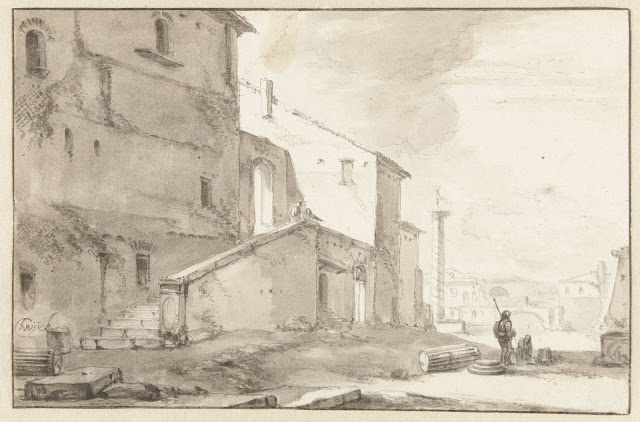 |
| Thomas Wijck Italian courtyard with well ca. 1644-53 drawing Rijksmuseum, Amsterdam |
 |
| Thomas Wijck Italian courtyard with fountain before 1677 drawing Teylers Museum, Haarlem |
 |
| Thomas Wijck Italian courtyard with well before 1677 drawing Rijksmuseum, Amsterdam |
"The earliest known work by Thomas Wijck (or Wyck) is an unsigned but dated drawing from 1643. . . . By then he had already completed his pupillage with Adriaen van Ostade, whose style left clear traces, particularly in the busy and vigorous use of the pen. Wijck's name appears for the first time in the books of the Guild of St Luke in Haarlem in 1642. He is not recorded in Haarlem in the period from the year of his marriage, 1644, until 1653, when a sister of his died. He could have been in Italy during this time, like Jan Baptist Weenix, who also set out for Italy after he had got married. . . . The 1643 drawing with an Italian motif, which was made in the Netherlands, is an indication that Wijck was already choosing Mediterranean subjects. He was following in the footsteps of Pieter van Laer, who had returned to Haarlem in 1639. A trip to Italy would have provided Wijck with a wealth of similar subjects that he could use in drawings and paintings. The locations he drew were not so much classical monuments and ruins as simple houses and courtyards which he could use as the settings for the ordinary people in his paintings. Other artists from the north were also drawing undistinguished buildings during this period."
– Peter Schatborn, from the catalogue of a 2001 exhibition at the Rijksmuseum, published in English as Drawn to Warmth: 17th-century Dutch artists in Italy, translated by Lynne Richards
 |
| Thomas Wijck Italian courtyard with stairs before 1677 drawing Morgan Library, New York |
 |
| Thomas Wijck Italian courtyard with stairs ca. 1644-53 drawing Rijksmuseum, Amsterdam |
 |
| Thomas Wijck Italian courtyard ca. 1644-53 drawing Rijksmuseum, Amsterdam |
 |
| Thomas Wijck Italian courtyard before 1677 drawing Rijksmuseum, Amsterdam |
 |
| Thomas Wijck Well in Italian courtyard before 1677 drawing Rijksmuseum, Amsterdam |
 |
| Thomas Wijck Italian building with well and staircase before 1677 drawing Rijksmuseum, Amsterdam |
 |
| Thomas Wijck Dwelling in Italian ruin before 1677 drawing Rijksmuseum, Amsterdam |
 |
| Thomas Wijck Italian street scene with houses before 1677 drawing Rijksmuseum, Amsterdam |
 |
| Thomas Wijck Italian street scene with ruins ca. 1644-53 drawing Rijksmuseum, Amsterdam |
 |
| Thomas Wijck Ripa Grande, Rome before 1677 drawing British Museum |
 |
| Thomas Wijck Italian houses and lime kiln before 1677 drawing Rijksmuseum, Amsterdam |
In the drawing directly above the low building at rear with sloping roof is a lime kiln, where limestone in various forms would have been burned to produce quicklime for building mortar. In Italian cities throughout the Middle Ages and the Renaissance a common and easily accessible source of limestone for burning was the quarried marble from Roman ruins and statuary. It could even be said that the urban landscape of Imperial Rome largely disappeared by gradual incineration within such obscure sheds as this neighborhood lime kiln.